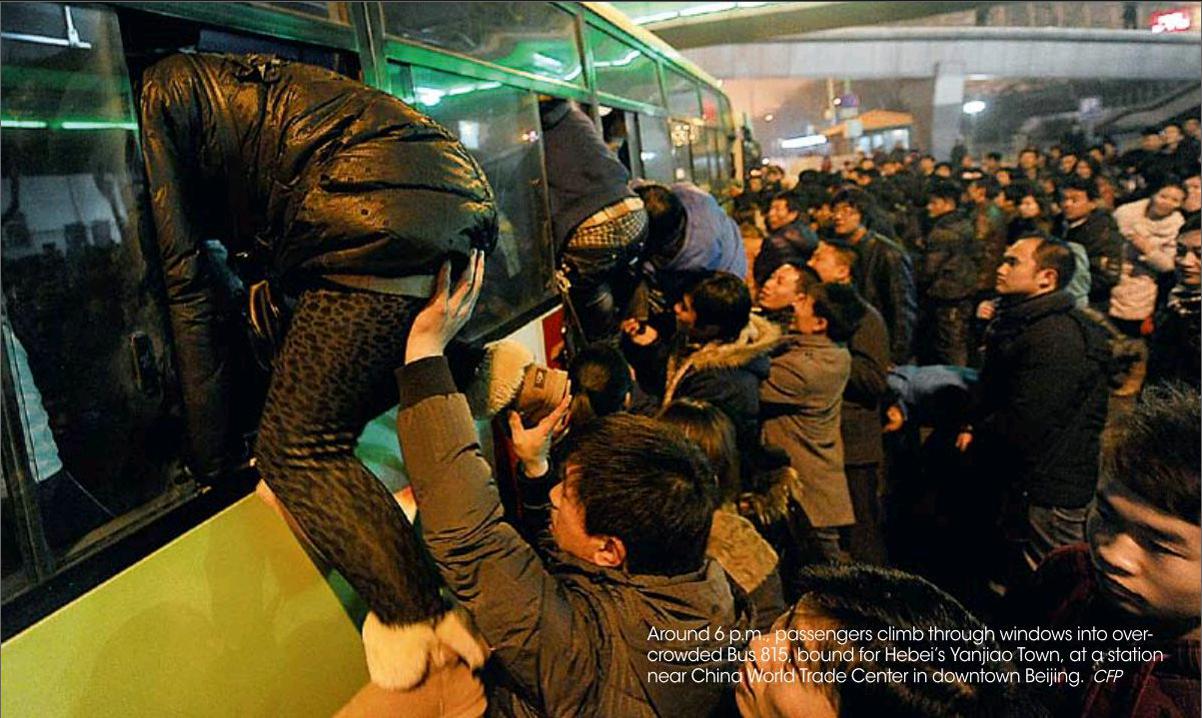Super Commuters
by+Zi+Mo

At 6 a.m., before the first rays of sun creep above the horizon, the bus station near Yanchaoming Distillery in Yanjiao Town, Hebei Province, is already crowded with passengers waiting for Bus 930, bound for downtown Beijing. Wang Yanpeng, who was born in the 1980s, stands among them. He has been waiting for 20 minutes after watching three overloaded buses pull away.
Rain or shine, Wang waits for the bus almost every weekday. He gets off at the China World Trade Center in Beijings Central Business District(CBD) and catches the subway. He transfers through three subway lines before finally reaching his office near Jiugong Station in Daxing District. One trip takes nearly two hours. In fact, some 300,000 workers just like Wang commute between homes in Yanjiao and workplaces in Beijing every day.
Sleeping Towns
East of Beijing, Yanjiao borders the capitals Tongzhou District and is actually only 30 kilometers from Tiananmen Square. Benefiting from a favorable location near downtown Beijing and a reputation as “backyard of the capital,” the Hebei town has, during the last decade, become home for more than 300,000 Beijing employees who cant afford to live in the city. They spend hours on the commute every single day.
Compared to smaller cities, Beijing is more prosperous and brimming with job opportunities. It has become the Promised Land for laborers from across the country. However, astronomical housing prices and living costs hinder many newcomers from settling in the city. Since 2005, real estate has skyrocketed. Housing prices inside Beijings Fifth Ring Road have tripled to more than 30,000 yuan per square meter, while the figure in Yanjiao sits at about 10,000 yuan per square meter – only half of the rate in Beijings Tongzhong District, which faces the Hebei town across a river. For this reason, many Beijing transplants choose to buy houses in neighboring Hebei towns, such as Yanjiao, Xianghe, and Guan.
Wang Shuang arrived in Beijing in 2008 and now works with a company in Chaoyang District. At first, he rented an apartment with a colleague. In 2011, he got married. With financial assistance from his parents, the couple bought an apartment in Yanjiao with a mortgage. “In Yanjiao, you can rent a two-bedroom apartment for what a basement room costs in Beijing,” Wang explains. “Many youngsters can afford a home in Yanjiao, but could never in Beijing. Actually, many of my colleagues had already purchased homes in Yanjiao before I did.”
However, the daily commute between Yanjiao and Beijing is a painful experience. No subway or commuter rails connect the cities, leaving bus as the only available public transportation. During rush hours, passengers are always packed like sardines on shuttling buses. “A man gets on, a picture gets off,” some joke. “Biscuits on, flour off.”
For these commuters, Yanjiao is only a place to rest their heads. Every other need is satisfied in Beijing. Perhaps few are willing to endure three or four hours of commuting daily throughout a lifetime. Many who are forced to sleep in Yanjiao still dream of settling permanently within Beijing proper, considering Yanjiao only a temporary stopover.
Growing Pains
For immigrants arriving in megacities such as Beijing, life isnt easy. They are welcomed with either jaw-dropping living costs or epic daily commutes. In fact, behind the dilemma is imbalanced regional development during Chinas urbanization. In recent years, along with the fast pace of the countrys urbanization, more and more people have swarmed into big cities. As a result, big cities further expand into sprawling megalopolises. Data released by Beijing Municipal Bureau of Statistics shows that by the end of 2013, the citys permanent population had surpassed 21 million, of which 8 million were migrants.
Any metropolis, regardless of size, cannot support endless population explosions. Like a centrifuge, when a city spins, the poor are catapulted away from the center and even out of the city. Along with the increasing expansion of cities, people are finding longer and longer journeys to work, and greater chunks of their lives devoted to commuting. According to a recent report issued by Social Survey and Research Center of Peking University, Beijingers daily spend 1.32 hours commuting between home and work, the longest average of any Chinese city, much longer than the national average of 0.96 hours. Along with traffic congestion, increasing distances between home and work are lengthening the trip.
In fact, the rise of super commuters isnt a phenomenon unique to Beijing. Kunshan, a city in Jiangsu Province, has become a “sleeping town” for many who work in neighboring Shanghai. Ultimately, the phenomenon stems from economic imbalances between cities and surrounding areas. Despite the fact that living costs are considerably lower in small and mediumsized cities, they offer fewer job opportunities and less-developed public service facilities. As population continues flowing to large cities, their bearing capacity nears a tipping point. Most new immigrants must dwell far from the city proper and endure lengthy, painful commutes every day.
Today, time spent commuting has become a key factor to evaluate quality of life. “It would be optimal if Yanjiao residents could work near where they live,”explains Professor Ding Yuanzhu from Chinese Academy of Governance. “However, this would require the government to adjust industrial layout, optimize the functional planning of urban agglomerations, and realize a balanced distribution of public service resources. We should stop letting cities expand blindly, and rationally distribute employment, education, and medical resources by building satellite cities to achieve an integration of dwelling and work.”
